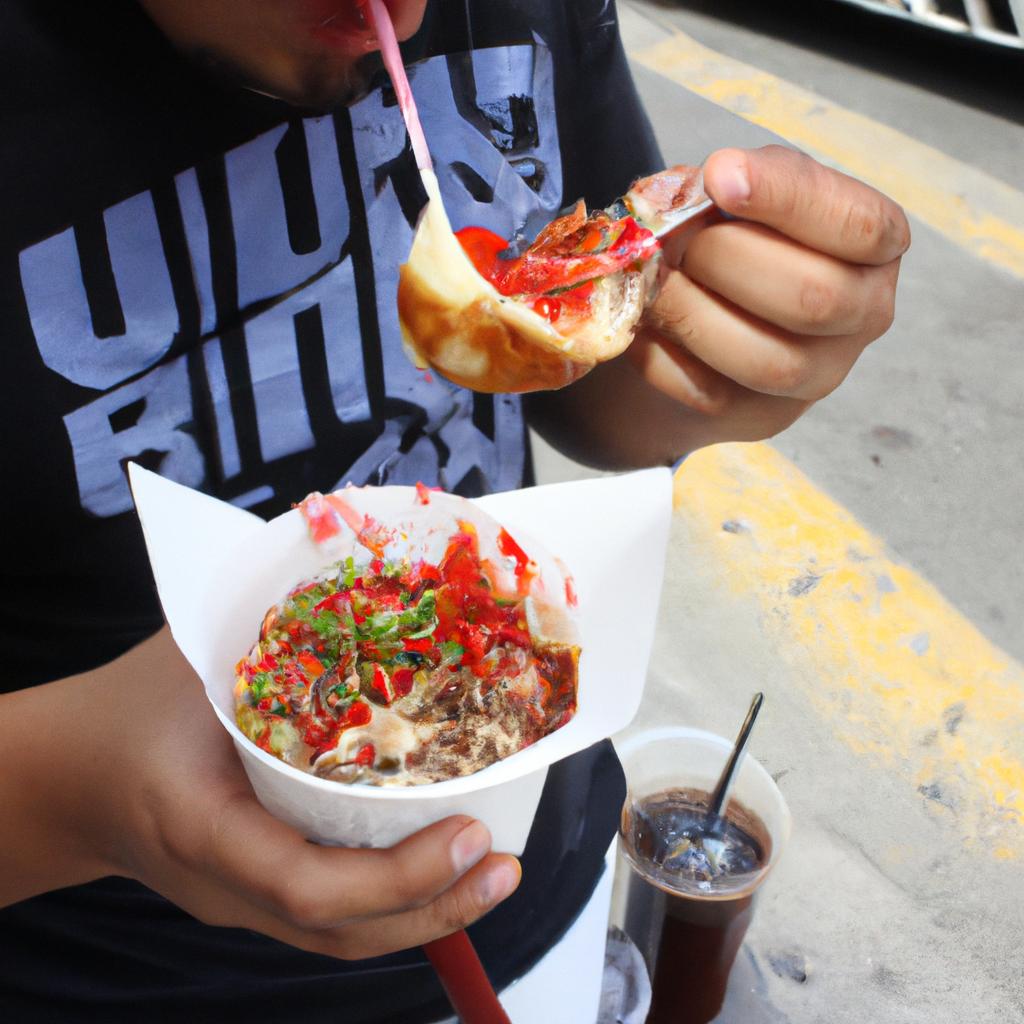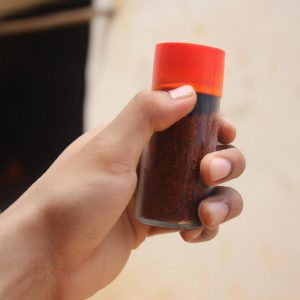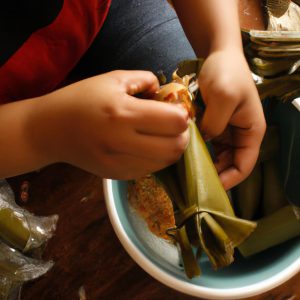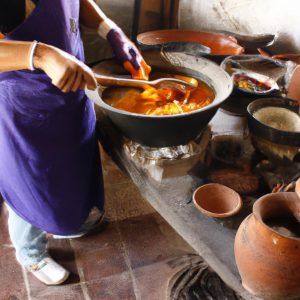The allure of Mexican street food lies in its vibrant flavors and rich cultural heritage. From the sizzling sounds of tacos being grilled on a busy street corner to the intoxicating aromas of freshly made elotes wafting through the air, exploring the world of Mexican street food is an adventure for the senses. This article aims to delve into the depths of this culinary tradition, uncovering not only the diverse range of dishes but also the stories behind them.
Imagine yourself strolling down the bustling streets of Mexico City, surrounded by colorful stalls and tantalizing smells emanating from every direction. Your eyes are immediately drawn to a small cart adorned with flags and filled with an array of ingredients that pique your curiosity. The vendor skillfully assembles a taco al pastor before your very eyes – layers of succulent marinated pork, juicy pineapple chunks, and fragrant herbs nestled inside a warm tortilla. As you take your first bite, you are instantly transported to another world – a world where flavor reigns supreme and each mouthful tells a story woven into the fabric of Mexican culture.
Through this exploration, we will examine how Mexican street food serves as more than just sustenance; it embodies history, tradition, and community. We will unravel the origins of iconic street food dishes such as tamales, quesadillas, and churros, tracing their roots back to ancient indigenous civilizations like the Aztecs and Mayans. These dishes were originally prepared using ingredients that were abundant in the region, such as maize, beans, chili peppers, and cacao.
Tamales, for example, can be traced back thousands of years to Mesoamerican cultures. Traditionally made by spreading masa (a dough made from corn) onto a corn husk and filling it with various ingredients such as meat or cheese, tamales were not only a delicious meal but also a portable source of sustenance for warriors on the go. Today, they remain a staple of Mexican street food culture and are enjoyed by locals and tourists alike.
Quesadillas are another beloved Mexican street food dish that has its origins in indigenous cuisine. The word “quesadilla” comes from the Spanish word “queso,” meaning cheese. Originally made with just cheese folded inside a tortilla and cooked until melted, modern variations often include additional fillings such as meats, vegetables, or even huitlacoche (a type of corn fungus). Quesadillas exemplify how simple ingredients can come together to create something truly extraordinary.
And who can resist the sweet temptation of churros? These deep-fried pastries coated in cinnamon sugar have become synonymous with Mexican street food culture. However, their origins can be traced back to Spain. Churros were introduced to Mexico during the colonial period and quickly became a popular treat among locals. Whether enjoyed plain or dipped in chocolate sauce, churros continue to delight taste buds all over Mexico.
Beyond the delicious flavors and historical significance, Mexican street food also fosters a sense of community. Food stalls act as gathering places where people from all walks of life come together to share a meal and engage in lively conversations. Street vendors, often passed down through generations, are not just culinary experts but also storytellers who preserve the traditions and cultural heritage of their dishes.
So next time you find yourself in Mexico or even just craving a taste of its vibrant cuisine, venture into the world of Mexican street food. Allow yourself to be seduced by the flavors, captivated by the stories, and embraced by the sense of community that this culinary tradition embodies. Your taste buds will thank you for the journey.
Tacos al pastor: A savory combination of marinated pork, pineapple, and spices, served on a warm tortilla
Mexican Street Food: Discovering the Flavors and Culture of the Streets
Tacos al pastor: A savory combination of marinated pork, pineapple, and spices, served on a warm tortilla.
Imagine strolling down the vibrant streets of Mexico City, surrounded by an enticing symphony of aromas wafting from food stalls. The sizzle of meat on a hot grill catches your attention, drawing you closer to a bustling taco stand. As you take your first bite into a perfectly crafted taco al pastor, layers of flavor explode in your mouth – tender marinated pork infused with aromatic spices and topped with juicy pineapple chunks. Tacos al pastor is just one example of the delectable Mexican street foods that tempt both locals and tourists alike.
The Origins and Preparation:
To truly appreciate tacos al pastor, it is essential to understand its rich history rooted in Lebanese cuisine. In the 20th century, Lebanese immigrants brought their culinary traditions to Mexico, including shawarma-style cooking methods using vertical spits called trompos. Over time, this fusion gave birth to tacos al pastor as we know them today – succulent strips of marinated pork cooked on rotating grills alongside sliced pineapples for added sweetness.
A harmonious blend of flavors characterizes these iconic street treats. The marinade typically consists of various ingredients such as achiote paste (a spice made from annatto seeds), vinegar, garlic, onions, cumin, oregano, and citrus juices like orange or lime. This fragrant mixture imparts tenderness and depth to the pork while infusing it with irresistible tanginess.
- Exploring the diverse range of fillings available for tacos al pastor will leave your taste buds craving more.
- Savoring each bite brings about a sense of adventure as you discover new combinations – perhaps spicy salsa verde or creamy guacamole.
- The affordability and accessibility of tacos al pastor make them a popular choice for locals, serving as a symbol of Mexican street food culture.
- Sharing this culinary experience with friends or strangers creates an atmosphere of communal enjoyment, uniting people from all walks of life.
Emotional Table:
| Flavorful Marinade | Succulent Pork | Fresh Pineapple | Warm Tortilla |
|---|---|---|---|
| Aromatic spices | Tender texture | Juicy sweetness | Soft base |
| Tangy undertones | Savory richness | Complementary | Comforting |
| Tantalizing aroma | Burst of flavor | Refreshing | Satisfying |
As we delve deeper into the world of Mexican street food delights, let us now turn our attention to another beloved dish: tamales. Steamed corn dough filled with various ingredients like meat, cheese, or vegetables, wrapped in a corn husk. These little bundles of joy encapsulate the essence of traditional Mexican cuisine and are eagerly consumed by locals and visitors alike.
Tamales: Steamed corn dough filled with various ingredients like meat, cheese, or vegetables, wrapped in a corn husk
Exploring the streets of Mexico, one cannot help but be captivated by the enticing aromas and vibrant colors that emanate from every corner. Now let us embark on another culinary adventure as we unravel the secrets behind Tamales – traditional Mexican delights wrapped in corn husks.
Imagine strolling down a bustling street in Mexico City, where food vendors line the sidewalks with an array of tempting offerings. Among them stands Maria, a skilled tamalera who has been perfecting her craft for years. Her humble stall attracts locals and tourists alike with the irresistible aroma of freshly steamed tamales wafting through the air.
To truly appreciate the artistry involved in creating these delectable treats, consider this hypothetical scenario: A hungry traveler approaches Maria’s stall and orders a savory tamale filled with succulent chicken tinga. As he eagerly unwraps it from its corn husk casing, his taste buds dance with delight at the tender masa dough enveloped around perfectly seasoned shredded chicken infused with smoky chipotle flavors.
Tamales hold deep cultural significance and are often enjoyed during festive occasions or family gatherings in Mexico. Here are four compelling reasons why they have become such an integral part of Mexican cuisine:
- Versatility: Whether stuffed with meat like beef barbacoa or vegetarian fillings like cheese and roasted poblano peppers, tamales offer endless possibilities to cater to diverse dietary preferences.
- Portability: The portable nature of tamales makes them ideal for street food culture. Their conveniently packaged form allows individuals to enjoy their flavorful contents while on-the-go.
- Tradition: Passed down through generations, tamale-making techniques reflect centuries-old traditions within Mexican households. Each family may have its own unique recipe, adding to the cultural richness of these culinary delights.
- Community Bonding: The process of making tamales often involves communal efforts, bringing family and friends together for a shared cooking experience. This fosters a sense of unity and strengthens social connections.
To further illustrate the significance of tamales in Mexican cuisine, let us explore their regional variations through this table:
| Region | Tamale Variation |
|---|---|
| Oaxaca | Tamales de mole |
| Veracruz | Zacahuil |
| Yucatán | Pib |
| Chiapas | Chipilín tamales |
As we conclude our exploration into the world of tamales, it becomes evident that these delightful treats go beyond being mere street food. They embody generations of tradition, community bonding, and the versatility that makes them an integral part of Mexico’s vibrant culinary heritage. Now, let us move on to discover another iconic street food delight – Elote: Grilled corn on the cob smothered in mayonnaise, cheese, chili powder, and lime juice – continuing our journey through the flavors and culture found amidst the bustling streets of Mexico.
Elote: Grilled corn on the cob smothered in mayonnaise, cheese, chili powder, and lime juice
Building on the diverse flavors of Mexican street food, let’s now explore another mouthwatering delight that tantalizes both locals and visitors alike.
Section H2: Churros: A Sweet Indulgence for Your Taste Buds
Imagine strolling down a bustling street in Mexico City, the aroma of freshly fried dough wafting through the air. You spot a vendor with a cart adorned with rows of golden brown churros glistening under the warm sunlight. Unable to resist, you purchase one and take your first bite – crispy on the outside, soft and fluffy on the inside, coated in a generous layer of cinnamon sugar. This delectable treat is known as churro; it has become synonymous with Mexican street food culture.
To further understand the allure of churros, consider these enticing aspects:
- Timeless Classic: Dating back centuries, churros have stood the test of time and remain an enduring favorite among people of all ages.
- Versatility at Its Finest: While traditional churros are typically enjoyed plain or dusted with cinnamon sugar, variations can be found across Mexico. Some vendors offer filled churros bursting with luscious fillings such as dulce de leche or Nutella.
- Simplicity Meets Complexity: Despite their uncomplicated ingredients – flour, water, salt – making perfect churros requires skillful technique. The dough must be piped into hot oil just long enough to achieve its signature crispness without becoming greasy.
- Cultural Symbolism: Beyond being a delightful snack, churros hold cultural significance in Mexico. They are often consumed during festive occasions like Independence Day celebrations or while enjoying leisurely walks along cobblestone streets.
| Timeless Classic | Versatility at Its Finest | Simplicity Meets Complexity | |
|---|---|---|---|
| 1 | Loved by all generations | Filled churro variations | Skilled technique required |
| 2 | Dating back centuries | Delicious dulce de leche | Perfect balance of crispness |
| 3 | Symbolic during festivals | Indulgent Nutella fillings | Uncomplicated ingredients |
As we delve deeper into the realm of Mexican street food, prepare yourself for a sensory journey that extends beyond savory delights.
Now let’s move on to our exploration of another beloved Mexican street food delight – Churros: Fried dough pastry dusted with cinnamon and sugar, perfect for satisfying your sweet tooth.
Churros: Fried dough pastry dusted with cinnamon and sugar, perfect for satisfying your sweet tooth
Moving on from the delightful flavors of Elote, let’s explore another staple of Mexican street food that is sure to satisfy your sweet tooth – Churros. These fried dough pastries are beloved by locals and visitors alike, offering a delectable combination of crispy exteriors and soft interiors.
Paragraph 1:
Imagine strolling through the bustling streets of Mexico City, the tantalizing scent of freshly fried Churros wafting through the air. You come across a small vendor with a crowd gathered around, eagerly waiting for their turn to indulge in this sugary delight. The vendor skillfully pipes out strips of dough into sizzling hot oil, transforming them into golden-brown churros. Once cooked to perfection, they are rolled in cinnamon and sugar, adding an irresistible sweetness.
- Indulgent Treats: Churros offer a decadent treat with their deep-fried goodness and sprinkling of cinnamon-sugar.
- Portable Delights: These handheld pastries make for convenient snacking as you explore the vibrant streetscape.
- Sweet Comfort: Whether enjoyed alone or shared with friends and family, churros provide a comforting taste that takes you back to childhood memories.
- Street Food Experience: Sampling churros from a street vendor adds an authentic touch to your culinary adventure.
Emotional Bullet Point List:
- Crispy yet fluffy texture
- Aromatic aroma filling the streets
- Warmth and comfort in every bite
- Irresistible contrast between sweet exterior and tender interior
Paragraph 2:
To further understand the popularity and versatility of churros within Mexican cuisine, let’s take a closer look at some interesting facts about these delightful treats:
| Fact | Description |
|---|---|
| Origin | Churros were introduced to Mexico during Spanish colonization but have since become deeply ingrained in local culture. |
| Variations | While the classic churro is a straight, elongated shape, variations such as loops or spirals can also be found. |
| Dipping Sauces | Churros are often served with delectable dipping sauces like chocolate ganache or dulce de leche. |
| Worldwide Appeal | The popularity of churros extends far beyond Mexico’s borders, with these treats being enjoyed in many countries around the world. |
Paragraph 3:
Indulging in freshly fried churros not only satisfies your sweet cravings but also offers a glimpse into the vibrant street food culture of Mexico. As you savor each bite, surrounded by the lively atmosphere and friendly chatter of locals, you become immersed in an experience that is truly unique to this culinary tradition.
Now that we have explored the delights of Churros, let’s move on to another mouthwatering snack – Sopes. These thick corn tortillas topped with beans, meat, cheese, and salsa create a delicious and filling treat perfect for any time of day.
Sopes: Thick corn tortillas topped with beans, meat, cheese, and salsa, creating a delicious and filling snack
Exploring the Vibrant World of Tacos al Pastor: A Fusion of Flavors and Traditions
Imagine walking down a bustling street in Mexico City, surrounded by vibrant colors, lively music, and enticing aromas. As you navigate through the crowd, your attention is drawn to a small food cart tucked away in a corner. The tantalizing smell of marinated pork grilling on a vertical spit fills the air, piquing your curiosity. You approach the cart and order a taco al pastor – a culinary delight that combines elements from different cultures to create an explosion of flavors.
Tacos al pastor have a fascinating history that reflects Mexico’s rich cultural heritage. This popular street food traces its origins back to Lebanese immigrants who settled in Mexico during the early 20th century. These newcomers brought with them their traditional dish called “shawarma,” which consists of thinly sliced meat cooked on a rotisserie. Over time, Mexican cooks adapted this technique by infusing it with local ingredients and spices, resulting in tacos al pastor as we know them today.
To truly appreciate the depth and complexity of tacos al pastor, let’s delve into its main components:
-
Marinated Pork: The key ingredient in this mouthwatering creation is succulent pork shoulder or leg meat, meticulously marinated for hours in a combination of aromatic spices such as dried chilies, garlic, onion, cumin, oregano, and pineapple juice. This marinade not only imparts exceptional flavor but also tenderizes the meat to perfection.
-
Vertical Spit Roasting: Once marinated, the pork is stacked onto a large vertical spit known as a trompo (meaning spinning top). As it rotates slowly over an open flame, layers upon layers of juicy meat are caramelized on the outside while retaining their tenderness inside.
-
Pineapple Topping: Adding another layer of complexity to these delectable treats is the use of fresh pineapple. Slices of this tropical fruit are placed on top of the spit, allowing their natural juices to drip down and infuse the meat with a hint of sweetness, balancing out the savory flavors.
-
Garnishes and Accompaniments: A taco al pastor is typically served on a small corn tortilla and topped with finely chopped onions, fragrant cilantro, tangy salsa verde or roja (green or red salsa), and sometimes finished off with a squeeze of lime juice for an extra burst of freshness.
This tantalizing street food has become synonymous with Mexican cuisine, captivating both locals and visitors alike. Its harmonious blend of cultures and diverse flavors make it a true culinary masterpiece that reflects Mexico’s multicultural heritage.
As we move forward in our exploration of Mexican street food, let’s now turn our attention to gorditas – another delightful creation that showcases the versatility of thick tortillas filled with various ingredients like meat, beans, or cheese.
Gorditas: Similar to sopes, these thick tortillas are split open and filled with various ingredients like meat, beans, or cheese
Mexican Street Food: Discovering the Flavors and Culture of the Streets
Section H2: Sopes: Thick corn tortillas topped with beans, meat, cheese, and salsa, creating a delicious and filling snack
Transition from the previous section:
After delving into the delightful world of sopes, let us now explore another delectable Mexican street food – gorditas. These thick tortillas are split open and filled with various ingredients like meat, beans, or cheese.
Gorditas have long been a staple in Mexican cuisine due to their versatility and satisfying flavors. To illustrate this point further, consider the hypothetical case of Maria who stumbles upon a bustling street food stall in Mexico City. Intrigued by the inviting aroma wafting through the air, she decides to try a gordita for the first time. The vendor offers her options such as succulent shredded beef combined with creamy refried beans or zesty marinated pork paired with tangy pickled onions. With each bite, Maria is captivated by the harmonious blend of textures and flavors that meld together within these handheld delights.
As we dive deeper into understanding gorditas, it is essential to recognize their cultural significance beyond being merely mouthwatering treats. Here are key aspects that contribute to their appeal:
- Traditional preparation methods passed down through generations.
- Use of local ingredients sourced from nearby markets.
- Influence from regional variations across different states in Mexico.
- Symbolic representation of community gatherings and celebrations.
To provide an overview of notable fillings commonly found in gorditas, refer to the following table showcasing some popular combinations:
| Filling | Description | Region |
|---|---|---|
| Cochinita Pibil | Slow-roasted pork marinated in citrus juice | Yucatan |
| Rajas con Queso | Strips of roasted poblano peppers with cheese | Puebla |
| Chicharron | Fried pork rinds | Mexico City |
| Huitlacoche | Corn fungus with a unique earthy flavor | Central |
In conclusion, gorditas offer an enticing culinary experience that goes beyond their scrumptious taste. These handheld delights showcase the rich tapestry of Mexican street food culture, blending traditional techniques and regional influences to create a diverse range of flavors and fillings. With each bite, one can savor not only the ingredients but also the stories woven into every gordita.
Moving forward from exploring gorditas, let us now turn our attention to another beloved Mexican street food – quesadillas. Melted cheese sandwiched between two tortillas, often served with a variety of fillings such as meat, vegetables, or mushrooms…
Quesadillas: Melted cheese sandwiched between two tortillas, often served with a variety of fillings such as meat, vegetables, or mushrooms
Tamales, a traditional Mexican delicacy, have been enjoyed for centuries and hold a special place in Mexican cuisine. These delightful bundles of flavor consist of masa (a dough made from corn) filled with various ingredients such as meat, cheese, or vegetables. The preparation process is intricate and time-consuming, but the end result is well worth the effort.
To illustrate the significance of tamales, let’s consider a hypothetical scenario. Imagine yourself strolling through the vibrant streets of Mexico City during a festive holiday season. The air is filled with tantalizing aromas wafting from street food stands. Your attention is captured by a bustling tamale vendor expertly crafting these savory treats. Intrigued, you decide to indulge in this culinary experience.
The beauty of tamales lies not only in their unique taste but also in the cultural heritage they represent. Here are some key aspects that make tamales an integral part of Mexican gastronomy:
- Rich History: Tamales trace their roots back to ancient Mesoamerican civilizations like the Aztecs and Mayans. They were traditionally offered as sacred offerings during religious ceremonies.
- Versatility: Tamales come in countless variations across different regions of Mexico, each boasting its own distinct flavors and fillings.
- Laborious Process: Crafting tamales requires patience and dedication. From preparing the masa to assembling and steaming them using banana leaves or corn husks, every step contributes to their exceptional texture and taste.
- Social Connection: Making tamales often involves gathering friends and family members together for a communal cooking experience known as “tamaladas.” This tradition fosters bonds while ensuring the preservation of ancestral recipes.
Table – Regional Varieties of Tamales:
| Region | Variety | Ingredients |
|---|---|---|
| Oaxaca | Tamales Oaxaqueños | Mole, chicken, wrapped in banana leaves |
| Veracruz | Zacahuil | Giant tamale stuffed with pork and chili peppers |
| Chiapas | Chipilín | Tamale filled with a local herb called chipilín |
| Mexico City | Green Chile | Tamale with green chile strips as the filling |
As we delve deeper into the world of Mexican street food, it is important to appreciate the cultural significance behind each delicacy. These culinary treasures not only satisfy our taste buds but also offer glimpses into vibrant traditions that have been passed down through generations.
Now let’s explore another beloved street food favorite – Agua fresca: Refreshing fruit-based drink made with fresh fruits, water, and sugar, perfect for quenching your thirst on a hot day.
Agua fresca: Refreshing fruit-based drink made with fresh fruits, water, and sugar, perfect for quenching your thirst on a hot day
Building on the diverse flavors of Mexican street food, let’s now delve into another popular dish that tantalizes taste buds and reflects the vibrant culinary culture found on the streets of Mexico.
Section:
Tacos al Pastor: A Culinary Journey Through Time
Imagine strolling down a bustling street in Mexico City, where the enticing aroma of sizzling meat wafts through the air. You find yourself drawn to a small food cart adorned with colorful decorations. The vendor skillfully slices tender marinated pork from a rotating spit and expertly places it onto warm tortillas. This mouthwatering creation is none other than tacos al pastor—a true gem of Mexican cuisine.
To fully appreciate this iconic dish, let us explore its origins and key ingredients. Tacos al pastor can be traced back to Lebanese immigrants who settled in Mexico during the early 20th century. Inspired by shawarma, they adapted their traditional recipe using local spices and techniques, resulting in a unique fusion of Middle Eastern and Mexican flavors.
The distinct flavor profile of tacos al pastor is achieved through several essential components:
- Marinated Pork: Thinly sliced pork shoulder or leg is soaked in a blend of spices such as guajillo chili powder, achiote paste, garlic, onion, and pineapple juice.
- Vertical Spit Roasting: The marinated pork is stacked onto a vertical rotisserie known as a trompo, similar to how shawarma is prepared. As it slowly rotates over an open flame or heat source for hours at a time, the meat becomes succulent and develops crispy caramelized edges.
- Garnishes: Topped off with finely chopped fresh cilantro, diced onions, tangy pineapple chunks, and sometimes served with lime wedges and spicy salsa verde or roja—tacos al pastor offer an explosion of contrasting textures and flavors.
While enjoying these flavorful tacos under the shade of umbrellas at roadside stands or stylish taquerias, it’s hard not to feel a sense of culinary adventure. The combination of aromatic spices, tender meat, and vibrant garnishes creates an experience that transports you to the lively streets of Mexico.
| Emotions Elicited by Tacos al Pastor |
|---|
| – Mouthwatering anticipation |
| – Nostalgic comfort |
| – Excitement for exploration |
| – Joyful indulgence |
Tacos al pastor exemplify the essence of Mexican street food culture—a harmonious blend of history, innovation, and irresistible flavors. As we continue our journey through these vibrant culinary traditions, let us now turn our attention to another beloved dish: tostadas—crispy tortillas topped with refried beans, meat, lettuce, tomato, cheese, and salsa—a delightful combination of flavors and textures.
Continuing on this delectable voyage into Mexican street food delights, let us uncover the world of tostadas without delay.
Tostadas: Crispy tortillas topped with refried beans, meat, lettuce, tomato, cheese, and salsa, creating a delightful combination of flavors and textures
Enchiladas are a popular dish in Mexican street food, known for their rich flavors and enticing aromas. These delectable rolled tortillas filled with various ingredients offer a delightful combination of textures and taste that will surely satisfy your cravings. Imagine sinking your teeth into a warm enchilada, its soft tortilla exterior giving way to a burst of savory fillings complemented by the vibrant sauces drizzled on top.
To better understand the appeal of enchiladas, let’s consider an example case study. Picture yourself strolling through the bustling streets of Mexico City, where vendors line up selling their mouthwatering culinary creations. As you approach one particular stall, the aroma of freshly cooked chicken enchiladas wafts through the air, drawing you closer. The vendor skillfully assembles each enchilada, carefully rolling shredded chicken into corn tortillas before topping them with tangy green salsa and melted cheese. Your senses are captivated by the sight, smell, and anticipation of this flavorful delight.
Here are some key elements that make enchiladas such a beloved street food:
- Versatility: Enchiladas can be made with various fillings such as beef, pork, cheese, or vegetables, offering options for different dietary preferences.
- Regional Variations: Different regions within Mexico have their own unique styles of preparing enchiladas, resulting in diverse flavor profiles across the country.
- Saucy Delight: The sauces used for enchiladas play a crucial role in enhancing their taste. Whether it’s a vibrant red sauce made from tomatoes and chili peppers or a tangy green sauce infused with herbs like cilantro and tomatillos, these sauces add depth and complexity to every bite.
- Garnishes Galore: Enchiladas often come adorned with garnishes like chopped onions, fresh cilantro, and tangy crema. These garnishes not only provide visual appeal but also contribute to the overall flavor experience.
Table: Regional Enchilada Variations
| Region | Key Characteristics |
|---|---|
| Mexico City | Green salsa, shredded chicken or cheese filling |
| Oaxaca | Mole sauce, traditional fillings like tasajo |
| Puebla | Red sauce with a touch of chocolate |
| Yucatan | Achiote marinade, topped with pickled onions |
As you can see, enchiladas offer a diverse range of flavors and preparations depending on the region. From the zesty green salsa in Mexico City to the rich mole sauce in Oaxaca, each variation provides a unique culinary experience that reflects the local culture and ingredients.
The next section will explore another beloved Mexican street food favorite: Ceviche. This dish showcases fresh seafood marinated in lime juice alongside vibrant vegetables and spices, making it a refreshing choice for those seeking a tangy delight amidst the bustling streets.
[Ceviche: Fresh seafood marinated in lime juice, mixed with onions, tomatoes, cilantro, and chili peppers, creating a tangy and refreshing dish]
Ceviche: Fresh seafood marinated in lime juice, mixed with onions, tomatoes, cilantro, and chili peppers, creating a tangy and refreshing dish
From the delectable world of tostadas, we now venture into another beloved Mexican street food: ceviche. Ceviche is a tantalizing dish that showcases the vibrant flavors and freshness of seafood combined with zesty ingredients. Imagine this scenario: you find yourself strolling down a bustling street in Mexico City on a warm summer day. As your appetite grows, you come across a vibrant food cart offering various types of ceviche, each promising an explosion of tangy and refreshing tastes.
Ceviche traditionally consists of fresh seafood marinated in lime juice, which enhances its natural flavors while effectively “cooking” the fish or shrimp. The acidity from the lime juice not only adds zest but also acts as a preservative, allowing for longer shelf life without compromising taste or quality. This technique has been perfected over generations by coastal communities, where fishermen would use their catch-of-the-day to create this delightful delicacy.
The combination of ingredients in ceviche creates a symphony of flavors that dance on your palate. Alongside the citrus-marinated seafood, onions add a subtle bite while tomatoes contribute juiciness and sweetness. Fragrant cilantro infuses an aromatic note, complemented by chili peppers that provide just the right amount of heat. When all these elements harmonize within your mouth, they transport you to the vibrant streets of Mexico, immersing you in its rich culinary traditions.
To truly appreciate the allure of ceviche’s flavor profile, let us delve deeper into what makes it so irresistible:
- Tangy: The lime juice imparts a tanginess that wakes up your taste buds and leaves them craving more.
- Fresh: The use of high-quality seafood ensures every bite bursts with freshness.
- Refreshing: Perfect for hot summer days or when you desire something light yet satisfying.
- Versatile: Ceviche can be made using different types of seafood such as fish, shrimp, or even octopus, allowing for endless variations to suit various palates.
Now, let’s take a closer look at the ingredients that come together to create this culinary masterpiece:
| Ingredients | Flavor Profile |
|---|---|
| Fresh seafood | Briny and delicate |
| Lime juice | Tangy and zesty |
| Onions | Subtly pungent |
| Tomatoes | Juicy and sweet |
| Cilantro | Fragrant and herbal |
| Chili peppers | Spicy kick |
As you savor each bite of ceviche, these flavors intertwine harmoniously, transporting you to sunny Mexican beaches where the aroma of freshly caught seafood fills the air. The simplicity yet complexity of this dish captures the essence of Mexican street food culture – vibrant, diverse, and immensely satisfying. So next time you find yourself in Mexico or seeking an adventure in your own kitchen, embrace the allure of ceviche and embark on a flavorful journey like no other.











More Stories
Tamales: A Delicious Mexican Street Food Delight
Elote: The Essential Mexican Street Food
Tacos al Pastor: Mexico’s Iconic Street Food